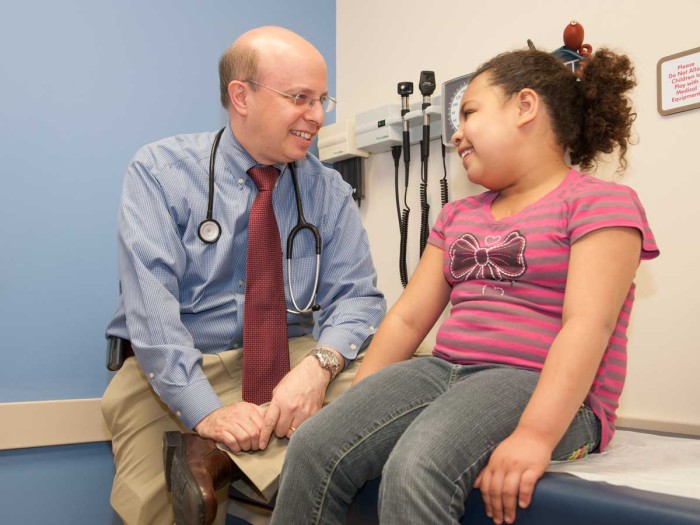For kids prone to wheezing with respiratory infections, early antibiotics help
Researchers aim to prevent progression of upper respiratory infections into lower respiratory tract illnesses

A new study led by Leonard Bacharier, MD, showed that giving a common antibiotic at the first sign of cold symptoms can reduce the risk of a common cold developing into a severe lower respiratory tract illness. The study was conducted in young children prone to such severe episodes but otherwise healthy. <em>Photo: Robert Boston</em>

Respiratory infections are common in preschoolers, but while most children recover fairly easily from the typical coughs and congestion, a significant number develop illnesses severe enough to interfere with breathing and warrant trips to urgent care clinics or emergency rooms.
In children whose colds tend to progress and lead to severe wheezing and difficulty breathing — such that they are given oral corticosteroids as rescue therapy — researchers have shown that giving a common antibiotic at the first sign of cold symptoms can reduce the risk of the episode developing into a severe lower respiratory tract illness.
The new study, led by researchers at Washington University School of Medicine in St. Louis, appears online Nov. 17 in JAMA.
“Oral corticosteroids such as prednisone have become the standard of care for these situations,” said lead author Leonard B. Bacharier, MD, professor of pediatrics. “But there are some studies that suggest these treatments don’t consistently work for young children. That’s why we want to find ways to prevent upper respiratory infections from progressing to lower respiratory tract illnesses. Once the episode gets going, standard interventions are less effective than would be desired.”
The investigators tested the antibiotic azithromycin against placebo in 607 children at nine academic medical centers nationwide. The children were ages 12 months to 6 years and had histories of developing severe lower respiratory tract illnesses but otherwise were healthy.
About equal numbers of respiratory infections were reported in both the antibiotic and placebo groups. But there was a significant difference in the severity of the infections experienced between the two groups. Of the 92 illnesses deemed severe because they required oral corticosteroids, 57 were in the placebo group compared with 35 in the group receiving azithromycin.
For this study, Bacharier and his colleagues chose to give the antibiotic at the highest FDA-approved dose for treating infection.
“We chose this antibiotic dose in order to try to maximize the anti-inflammatory effects,” said Bacharier, who treats patients at St. Louis Children’s Hospital. “But we don’t know if this is why we saw less severe disease in children receiving early azithromycin treatment. It also could work because it is preventing or treating bacterial infections.”
The protocol for dispensing the antibiotic also differed from typical courses of these drugs. Parents were given the antibiotic to have on hand at home so they could give it at the earliest signs of cold symptoms. The investigators worked with each family to identify a set of early symptoms that would indicate to parents to begin the treatment course.
“We helped families identify the collection of symptoms that triggers that internal alarm parents have that says, ‘Here we go again,’” Bacharier said. “That’s when we wanted them to start giving the antibiotic. We think the earlier you get it going, the more effective the intervention will be.”
Because of concerns over the development of antibiotic-resistant organisms, Bacharier and his colleagues studied azithromycin resistance in a subset of 86 patients seen at St. Louis Children’s Hospital.
“We saw that there were children who received azithromycin during the study who, at the end of the study, had azithromycin-resistant germs in their throats,” Bacharier said. “But we also saw, at nearly but not quite the same rate, azithromycin-resistant bacteria in children who did not receive any of the antibiotic. So we don’t fully understand the effect of azithromycin on antibiotic resistance.”
Bacharier said a larger study is necessary to determine whether the difference in the rates of developing azithromycin resistance are statistically or clinically meaningful. He also noted that those children shown to have bacteria resistant to azithromycin did not fare any differently in the study than those who did not have azithromycin-resistant organisms.
Bacharier added that about one in six visits to doctors for asthma symptoms in the United States results in the child being prescribed an antibiotic. But this is usually after the episode has become severe.
“We want to be prudent with our antibiotic use,” he said. “We don’t want to overdo this. On the other hand, these are children having severe episodes for which we don’t have a lot of effective therapy. A significant number are getting an antibiotic therapy anyway and have to be very sick to get it. Our study suggests we can reduce the risk of severe respiratory illnesses by giving azithromycin treatment earlier.”
Bacharier also pointed out that even among children who developed severe illnesses while on azithromycin, overall symptoms were less severe than in those who received placebo. The study also demonstrated that despite the benefit in reducing episode severity, this treatment strategy does not lengthen time between infections or prevent them from happening.
He said one of the next steps for this particular intervention is to see if it is similarly effective in children who are receiving daily asthma therapy.
“We showed this worked for the children we studied who did not need daily asthma therapy,” he said. “Now we would like to investigate what will happen in a group of children at the next step of the disease severity ladder.”






